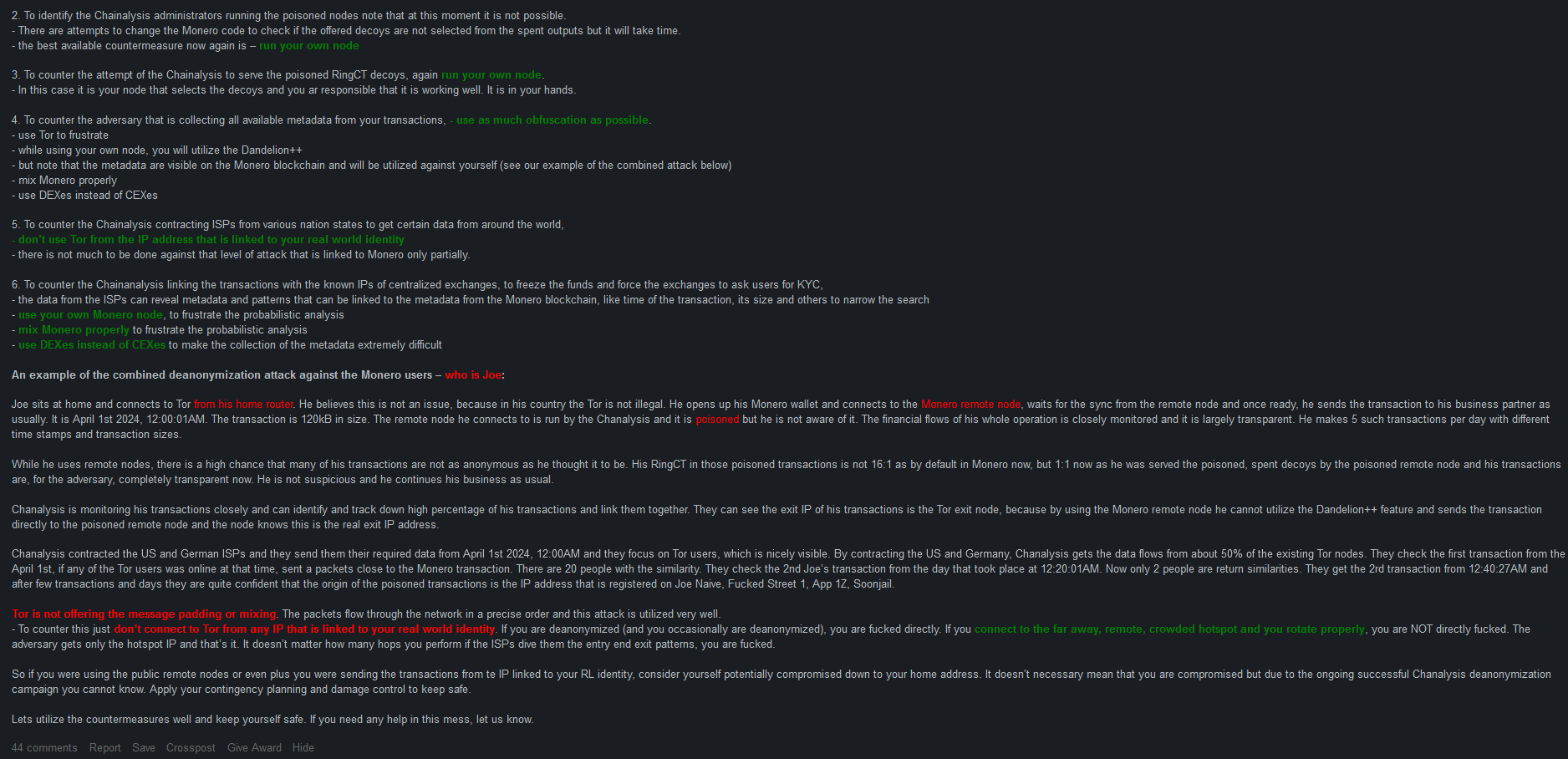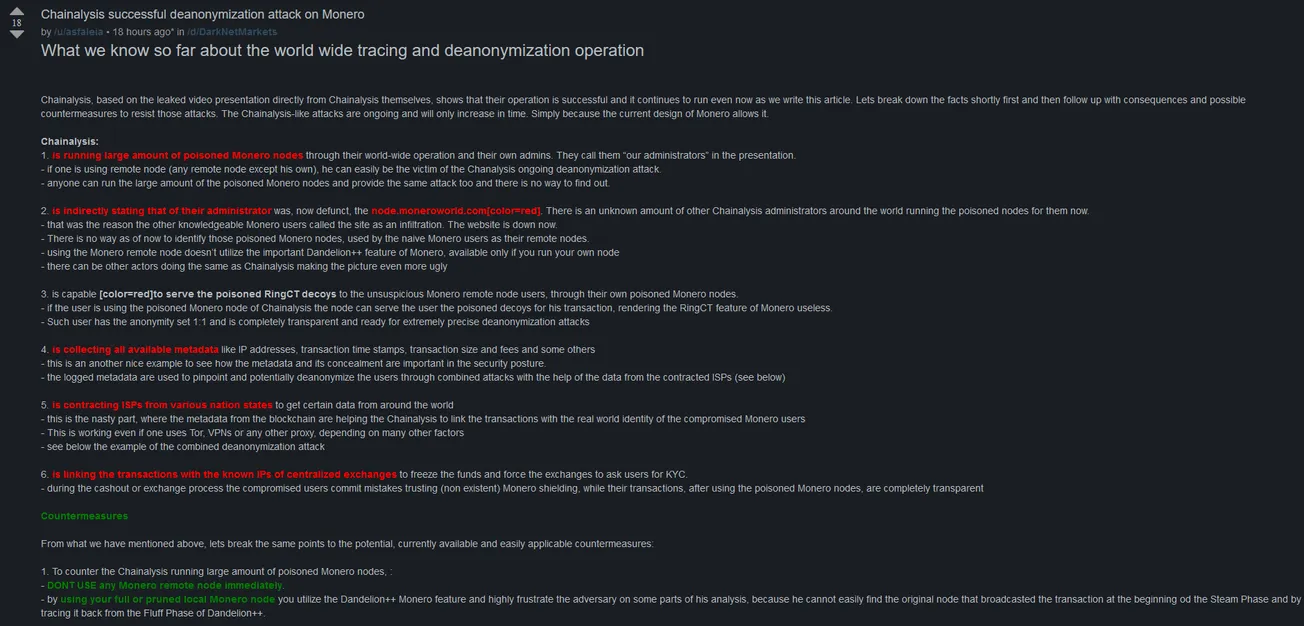Follow the thread on Dread: http://dreadytofatroptsdj6io7l3xptbet6onoyno2yv7jicoxknyazubrad.onion/post/6de54b143e669e368af6


UPDATE: Because a lot of people don't insist on going to the thread and reading comments. Please look at the comment below from the same person who made the thread.

What we know so far about the world wide tracing and deanonymization operation
Chainalysis, based on the leaked video presentation directly from Chainalysis themselves, shows that their operation is successful and it continues to run even now as we write this article. Lets break down the facts shortly first and then follow up with consequences and possible countermeasures to resist those attacks. The Chainalysis-like attacks are ongoing and will only increase in time. Simply because the current design of Monero allows it.
Chainalysis:
- is running large amount of poisoned Monero nodes through their world-wide operation and their own admins. They call them “our administrators” in the presentation.
- if one is using remote node (any remote node except his own), he can easily be the victim of the Chanalysis ongoing deanonymization attack.
- anyone can run the large amount of the poisoned Monero nodes and provide the same attack too and there is no way to find out.
- is indirectly stating that of their administrator was, now defunct, the node.moneroworld.com[color=red]. There is an unknown amount of other Chainalysis administrators around the world running the poisoned nodes for them now.
- that was the reason the other knowledgeable Monero users called the site as an infiltration. The website is down now.
- There is no way as of now to identify those poisoned Monero nodes, used by the naive Monero users as their remote nodes.
- using the Monero remote node doesn’t utilize the important Dandelion++ feature of Monero, available only if you run your own node
- there can be other actors doing the same as Chainalysis making the picture even more ugly
- is capable [color=red]to serve the poisoned RingCT decoys to the unsuspicious Monero remote node users, through their own poisoned Monero nodes.
- if the user is using the poisoned Monero node of Chainalysis the node can serve the user the poisoned decoys for his transaction, rendering the RingCT feature of Monero useless.
- Such user has the anonymity set 1:1 and is completely transparent and ready for extremely precise deanonymization attacks
- is collecting all available metadata like IP addresses, transaction time stamps, transaction size and fees and some others
- this is an another nice example to see how the metadata and its concealment are important in the security posture.
- the logged metadata are used to pinpoint and potentially deanonymize the users through combined attacks with the help of the data from the contracted ISPs (see below)
- is contracting ISPs from various nation states to get certain data from around the world
- this is the nasty part, where the metadata from the blockchain are helping the Chainalysis to link the transactions with the real world identity of the compromised Monero users
- This is working even if one uses Tor, VPNs or any other proxy, depending on many other factors
- see below the example of the combined deanonymization attack
- is linking the transactions with the known IPs of centralized exchanges to freeze the funds and force the exchanges to ask users for KYC.
- during the cashout or exchange process the compromised users commit mistakes trusting (non existent) Monero shielding, while their transactions, after using the poisoned Monero nodes, are completely transparent
Countermeasures
From what we have mentioned above, lets break the same points to the potential, currently available and easily applicable countermeasures:
- To counter the Chainalysis running large amount of poisoned Monero nodes, :
- DONT USE any Monero remote node immediately.
- by using your full or pruned local Monero node you utilize the Dandelion++ Monero feature and highly frustrate the adversary on some parts of his analysis, because he cannot easily find the original node that broadcasted the transaction at the beginning od the Steam Phase and by tracing it back from the Fluff Phase of Dandelion++.
- To identify the Chainalysis administrators running the poisoned nodes note that at this moment it is not possible.
- There are attempts to change the Monero code to check if the offered decoys are not selected from the spent outputs but it will take time.
- the best available countermeasure now again is – run your own node
- To counter the attempt of the Chainalysis to serve the poisoned RingCT decoys, again run your own node.
- In this case it is your node that selects the decoys and you ar responsible that it is working well. It is in your hands.
- To counter the adversary that is collecting all available metadata from your transactions, - use as much obfuscation as possible.
- use Tor to frustrate
- while using your own node, you will utilize the Dandelion++
- but note that the metadata are visible on the Monero blockchain and will be utilized against yourself (see our example of the combined attack below)
- mix Monero properly
- use DEXes instead of CEXes
- To counter the Chainalysis contracting ISPs from various nation states to get certain data from around the world,
- don’t use Tor from the IP address that is linked to your real world identity
- there is not much to be done against that level of attack that is linked to Monero only partially.
- To counter the Chainanalysis linking the transactions with the known IPs of centralized exchanges, to freeze the funds and force the exchanges to ask users for KYC,
- the data from the ISPs can reveal metadata and patterns that can be linked to the metadata from the Monero blockchain, like time of the transaction, its size and others to narrow the search
- use your own Monero node, to frustrate the probabilistic analysis
- mix Monero properly to frustrate the probabilistic analysis
- use DEXes instead of CEXes to make the collection of the metadata extremely difficult
An example of the combined deanonymization attack against the Monero users – who is Joe:
Joe sits at home and connects to Tor from his home router. He believes this is not an issue, because in his country the Tor is not illegal. He opens up his Monero wallet and connects to the Monero remote node, waits for the sync from the remote node and once ready, he sends the transaction to his business partner as usually. It is April 1st 2024, 12:00:01AM. The transaction is 120kB in size. The remote node he connects to is run by the Chanalysis and it is poisoned but he is not aware of it. The financial flows of his whole operation is closely monitored and it is largely transparent. He makes 5 such transactions per day with different time stamps and transaction sizes.
While he uses remote nodes, there is a high chance that many of his transactions are not as anonymous as he thought it to be. His RingCT in those poisoned transactions is not 16:1 as by default in Monero now, but 1:1 now as he was served the poisoned, spent decoys by the poisoned remote node and his transactions are, for the adversary, completely transparent now. He is not suspicious and he continues his business as usual.
Chanalysis is monitoring his transactions closely and can identify and track down high percentage of his transactions and link them together. They can see the exit IP of his transactions is the Tor exit node, because by using the Monero remote node he cannot utilize the Dandelion++ feature and sends the transaction directly to the poisoned remote node and the node knows this is the real exit IP address.
Chanalysis contracted the US and German ISPs and they send them their required data from April 1st 2024, 12:00AM and they focus on Tor users, which is nicely visible. By contracting the US and Germany, Chanalysis gets the data flows from about 50% of the existing Tor nodes. They check the first transaction from the April 1st, if any of the Tor users was online at that time, sent a packets close to the Monero transaction. There are 20 people with the similarity. They check the 2nd Joe’s transaction from the day that took place at 12:20:01AM. Now only 2 people are return similarities. They get the 2rd transaction from 12:40:27AM and after few transactions and days they are quite confident that the origin of the poisoned transactions is the IP address that is registered on Joe Naive, Fucked Street 1, App 1Z, Soonjail.
Tor is not offering the message padding or mixing. The packets flow through the network in a precise order and this attack is utilized very well.
- To counter this just don’t connect to Tor from any IP that is linked to your real world identity. If you are deanonymized (and you occasionally are deanonymized), you are fucked directly. If you connect to the far away, remote, crowded hotspot and you rotate properly, you are NOT directly fucked. The adversary gets only the hotspot IP and that’s it. It doesn’t matter how many hops you perform if the ISPs dive them the entry end exit patterns, you are fucked.
So if you were using the public remote nodes or even plus you were sending the transactions from te IP linked to your RL identity, consider yourself potentially compromised down to your home address. It doesn’t necessary mean that you are compromised but due to the ongoing successful Chanalysis deanonymization campaign you cannot know. Apply your contingency planning and damage control to keep safe.
Lets utilize the countermeasures well and keep yourself safe. If you need any help in this mess, let us know.









